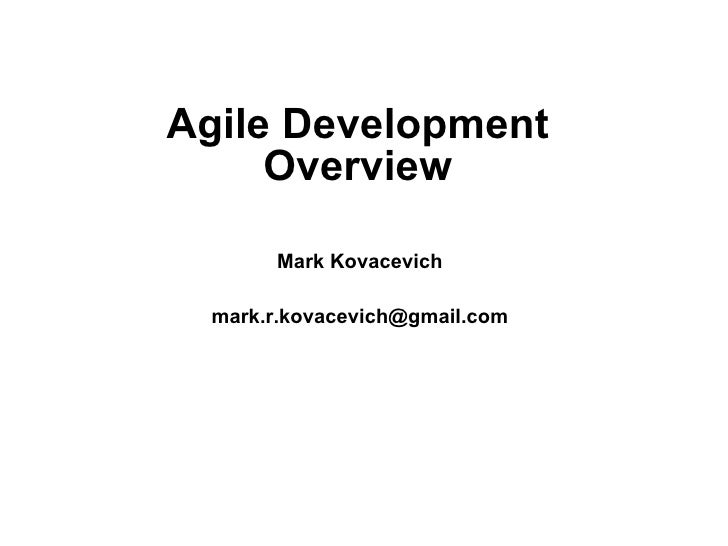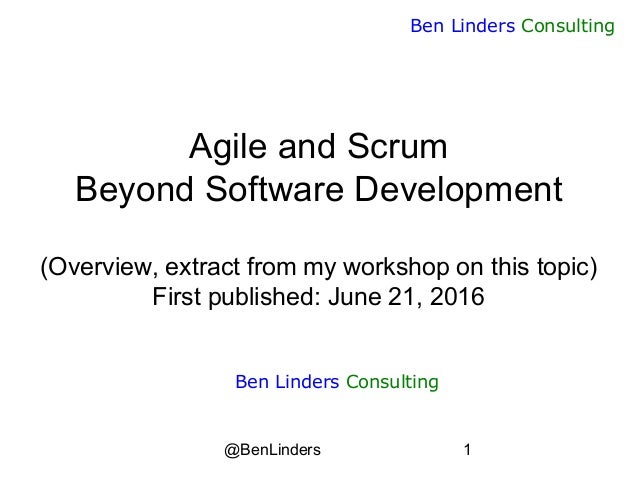Introduction to Agile Methodologies SCRUM (most popular) is an iterative process of development used with agile software development. The roles in Scrum are the ScrumMaster, the Product Owner and the Team. Agile Software development is based on 12 guiding principles, which are set out in the Agile Manifesto 13. Our highest priority is to satisfy the customer through early and continuous deliver of valuable software. Welcome changing requirements, even late in development. Agile SDLC model is a combination of iterative and incremental process models with focus on process adaptability and customer satisfaction by rapid delivery of working software product. Agile Methods break the product into small incremental builds. These builds are provided in iterations. Ravetree is a full-featured Agile Work Management® software platform that includes best-in-class Agile project management, resource planning, time & expense tracking, digital asset management, and CRM. Unlike other Agile project management tools that are built primarily for software teams, Ravetree is built for Agile organizations.
- SDLC Tutorial
Agile software development methodology is an process for developing software (like other software development methodologies – Waterfall model, V-Model, Iterative model etc.) However, Agile methodology differs significantly from other methodologies. Broadcom bcm20702a0 driver windows 10. In English, Agile means ‘ability to move quickly and easily’ and responding swiftly to change – this is a key aspect of Agile software. Continuous Integration in Agile Software Development Traditional software development methods don’t dictate how frequently to integrate source code. The more programmers share code, the more problematic it is. Agile teams may use Continuous Integration.
- SDLC Useful Resources
- Selected Reading
Agile SDLC model is a combination of iterative and incremental process models with focus on process adaptability and customer satisfaction by rapid delivery of working software product. Agile Methods break the product into small incremental builds. These builds are provided in iterations. Each iteration typically lasts from about one to three weeks. Every iteration involves cross functional teams working simultaneously on various areas like −
- Planning
- Requirements Analysis
- Design
- Coding
- Unit Testing and
- Acceptance Testing.
At the end of the iteration, a working product is displayed to the customer and important stakeholders.
What is Agile?
Agile model believes that every project needs to be handled differently and the existing methods need to be tailored to best suit the project requirements. In Agile, the tasks are divided to time boxes (small time frames) to deliver specific features for a release.
Iterative approach is taken and working software build is delivered after each iteration. Each build is incremental in terms of features; the final build holds all the features required by the customer.
Agile Methodology Overview
Here is a graphical illustration of the Agile Model −
The Agile thought process had started early in the software development and started becoming popular with time due to its flexibility and adaptability.
The most popular Agile methods include Rational Unified Process (1994), Scrum (1995), Crystal Clear, Extreme Programming (1996), Adaptive Software Development, Feature Driven Development, and Dynamic Systems Development Method (DSDM) (1995). These are now collectively referred to as Agile Methodologies, after the Agile Manifesto was published in 2001.

Following are the Agile Manifesto principles −
Individuals and interactions − In Agile development, self-organization and motivation are important, as are interactions like co-location and pair programming.
Working software − Demo working software is considered the best means of communication with the customers to understand their requirements, instead of just depending on documentation.
Customer collaboration − As the requirements cannot be gathered completely in the beginning of the project due to various factors, continuous customer interaction is very important to get proper product requirements.
Responding to change − Agile Development is focused on quick responses to change and continuous development.
Agile Vs Traditional SDLC Models
Agile is based on the adaptive software development methods, whereas the traditional SDLC models like the waterfall model is based on a predictive approach. Predictive teams in the traditional SDLC models usually work with detailed planning and have a complete forecast of the exact tasks and features to be delivered in the next few months or during the product life cycle.
Predictive methods entirely depend on the requirement analysis and planning done in the beginning of cycle. Any changes to be incorporated go through a strict change control management and prioritization.

Agile uses an adaptive approach where there is no detailed planning and there is clarity on future tasks only in respect of what features need to be developed. There is feature driven development and the team adapts to the changing product requirements dynamically. The product is tested very frequently, through the release iterations, minimizing the risk of any major failures in future.
Customer Interaction is the backbone of this Agile methodology, and open communication with minimum documentation are the typical features of Agile development environment. Super mario flash games. The agile teams work in close collaboration with each other and are most often located in the same geographical location.
Agile Model - Pros and Cons
Agile methods are being widely accepted in the software world recently. However, this method may not always be suitable for all products. Here are some pros and cons of the Agile model.
The advantages of the Agile Model are as follows −
Is a very realistic approach to software development.
Effra heavy font free printable. Char map Effra Heavy Regular font EFFRASTDHE.TTF, Effra Heavy Regular, effra-heavy, Effra Heavy Regular, effra-heavy, EffraStdHe.ttf, Windows, TTF, font The fonts presented on this website are their authors' property, and are either freeware, shareware, demo versions or public domain. The best website for free high-quality Effra Heavy fonts, with 27 free Effra Heavy fonts for immediate download, and 10 professional Effra Heavy fonts for the best price on the Web. Download Effra Heavy font for PC/Mac for free, take a test-drive and see the entire character set. Moreover, you can embed it to your website with @font-face support. Effra HeavyRegularJonasSchudelandDaltonMaagLtd.: Effra Heavy: 2008Effra HeavyVersion 1. 000EffraHeavy-RegularEffra is a trademark of Jonas Schudel and Dalton Maag Ltd. Nov 26, 2015 Effra Font You can download and use Effra font free for your own personal and business projects. Also you can develop client’s based projects. Apparently we had reached a great height in the atmosphere, for the sky was a dead black, and the stars had ceased to twinkle.
Promotes teamwork and cross training.
Functionality can be developed rapidly and demonstrated.
Resource requirements are minimum.
Suitable for fixed or changing requirements
Delivers early partial working solutions.
Good model for environments that change steadily.
Minimal rules, documentation easily employed.
Enables concurrent development and delivery within an overall planned context.
Little or no planning required.
Easy to manage.
Gives flexibility to developers.
Agile Software Development Overview
The disadvantages of the Agile Model are as follows −
Not suitable for handling complex dependencies.
More risk of sustainability, maintainability and extensibility.
An overall plan, an agile leader and agile PM practice is a must without which it will not work.
Strict delivery management dictates the scope, functionality to be delivered, and adjustments to meet the deadlines.
Depends heavily on customer interaction, so if customer is not clear, team can be driven in the wrong direction.
There is a very high individual dependency, since there is minimum documentation generated.
Transfer of technology to new team members may be quite challenging due to lack of documentation.
- Agile Tutorial
- Agile Useful Resources
- Selected Reading
Agile is a software development methodology to build a software incrementally using short iterations of 1 to 4 weeks so that the development is aligned with the changing business needs. This simple tutorial uses appropriate examples to help you understand agile development in a general and quick way.
This tutorial has been prepared for beginners to help them understand the basics of Agile principles and its implementation. After completing this tutorial, you will find yourself at a moderate level of expertise, from where you can advance further.
Before proceeding with this tutorial, you need a basic knowledge of software development concepts such as software requirements, coding, testing, etc.